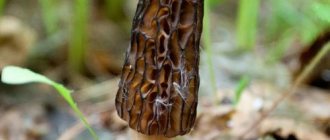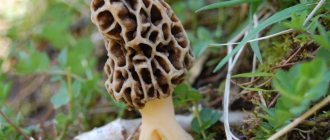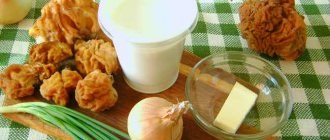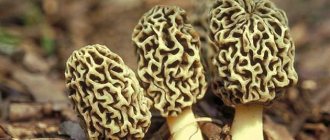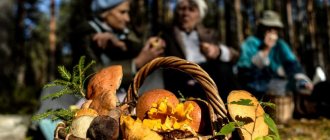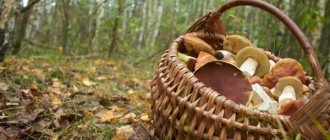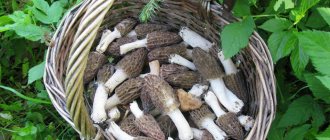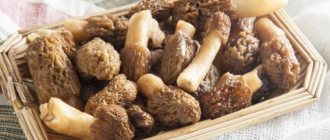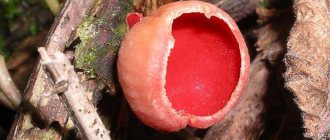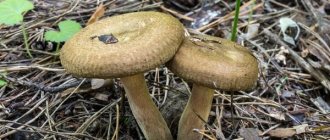Morels (Morchella) are a genus of mushrooms of the morel family, which belong to the class of marsupial fungi or ascomycetes. It is important to distinguish a mushroom with a porous body from stitches, which are poisonous. About the features of appearance, how to distinguish morels from other mushrooms, about the benefits and harms, as well as methods of use and cultivation - later in the article.
What you need to know before collecting
The very first thing a mushroom picker must know is which morels can be collected in his area and which cannot. And the only source of this information is
Red Book
At the time of writing, no morels are included in the Red Book of the Russian Federation. However, some of them in some regions are still listed in the Red Book (for example, the steppe morel). Therefore, collecting them is purely legally considered poaching. Therefore, before going into the forest, it would be a good idea to look into the regional CC and find out if any of the morels discussed in this article are there.
Lines (not morels at all)
Photo 3. An ordinary stitch, which has nothing to do with real morels. Author: ChristianSW.
There is another category of spring mushrooms - stitches. They differ from morels in appearance, and they can also be called the most controversial mushrooms - due to the likelihood of containing very toxic substances, the concentration of which varies from region to region - from zero to lethal. That is, somewhere they are collected and eaten, and seemingly without harm, but somewhere they are completely poisoned. The lines will not be discussed here - they should be devoted to a separate article.
And to distinguish a morel from a string, you need to look at the cap. In the morel, the structure of the fruiting body looks clearly more “geometric”, and its cap is somewhat reminiscent of a sponge or honeycomb. The stitch is more shapeless, and thanks to the winding folds, it looks more like a walnut or dried fruit . In addition, the stem of the morel is usually hollow, while the stem is filled with the same winding partitions.
Photo 4. On the left is a morel, on the right is a line. The difference in the shape and structure of the caps is quite obvious so that these two mushrooms are not confused. Authors: Toffel and Jörg Hempel.
Be careful: ticks!
The collection of morels and morel caps occurs at the peak of tick activity, and mushrooms usually grow in places where bloodsuckers are swarming. And as you know, these evil spirits now carry all kinds of infections, including those for which no vaccinations have yet been invented.
What to do? Firstly, dress appropriately, for example, use a special anti-encephalitis suit, shoes with ankle boots or boots - where you can easily tuck in your pants. Secondly, use chemicals to repel and kill ticks. Thirdly, do not be lazy to inspect yourself and your companions for tick-borne “landing”.
Read more about how to protect yourself from ticks in the spring forest in the article “Remedies for ticks: protection while hiking and fishing.”
And now, perhaps, it’s time to move on to mushrooms.
Can morels be grown at home?
Morels are delicious mushrooms that are considered a delicacy in European countries. Therefore, attempts have been made more than once to grow mushrooms at home.
German mushroom pickers suggested simply sowing pieces of morels into the ground and covering them with ash. In the fall, the top area is covered with straw or leaves, and in the spring, mushrooms are already found. It was also noticed that morels grow well in those places where fallen, rotting apples remain. That's why the French make beds on which they scatter pieces of mushrooms. In autumn, the ground is watered with apple pomace. In the spring the harvest is harvested.
Morel mycelium can be purchased at a specialty store and planted in the garden. Morels are planted in the spring. To do this, select a “mushroom” place on it near deciduous trees. It should be darkened. In the selected area, 15 cm of the top layer is removed.
Prepare the soil mixture:
- 3 parts sawdust;
- 1 part leaves;
- 1 part wood ash;
- 6 parts garden soil.
All components are mixed and poured into the prepared hole and watered. The mycelium is laid on top of the soil and covered with removed soil. Water again and cover the bed with leaves. In the summer they look after it, do not let the soil dry out and fertilize it with wood ash. In autumn, they are covered with natural materials - straw, branches, leaves. In the spring, after the snow melts, the cover is removed. The first mushrooms will appear in 2 weeks. The mycelium bears fruit for 3-5 years.
The morel is real, it's also edible
It is one of the largest morels and is also distinguished by the most massive fruiting. The fruiting body reaches a height of 20 cm with a cap diameter of up to 8 cm. The color of the cap is from ocher to gray, becoming darker over time. The stem of young fruiting bodies is white; as it ripens, it changes shade towards brown.
- Where it grows: the edible morel is widespread in the forest zone of Eurasia (it is found only in the Arctic Circle), found in North America, found in Australia and on the island of Tasmania. Prefers calcareous soils and bright places. It is collected in deciduous and mixed forests, on forest edges and clearings, in parks, gardens and even vegetable gardens (this is more often observed in southern latitudes).
- When to collect: in our area it usually appears in early May, but in especially warm springs - when the snow in the forest melts quickly - it can be found as early as April, or even at the end of March. If the spring is cold, then the timing of the appearance of this mushroom may shift to the end of May, then its fruiting will last until mid-June. It usually bears fruit in a single layer, but can produce a second layer in the fall. The author of these lines happened to discover this mushroom at the end of September (hence it can be classified not only as spring, but also autumn mushrooms), and if you believe the reference books, then morels can be found in the first ten days of October, but this happens in particularly warm seasons.
Chemical composition
Morels are classified as low-calorie products, since their energy value is 30 kilocalories per 100 g.
Table No. 1 “Nutritional value of morels”
| Name | Component content per 100 g of fruiting bodies, grams |
| Water | 89,61 |
| Squirrels | 3,12 |
| Alimentary fiber | 2,8 |
| Carbohydrates | 2,3 |
| Ash | 1,58 |
| Fats | 0,57 |
Table No. 2 “Chemical composition of morels”
| Name | Substance concentration in 100 g of fresh mushroom, milligram |
| Vitamins | |
| Niacin (PP) | 2,25 |
| Pantothenic acid (B5) | 0,44 |
| Riboflavin (B2) | 0,21 |
| Pyridoxine (B6) | 0,15 |
| Thiamine (B1) | 0,08 |
| Folic acid (B9) | 0,009 |
| Ergocalciferol (D2) | 0,0051 |
| Macronutrients | |
| Potassium | 411 |
| Phosphorus | 194 |
| Calcium | 43 |
| Sodium | 21 |
| Magnesium | 19 |
| Microelements | |
| Iron | 12,18 |
| Zinc | 2,03 |
| Copper | 0,63 |
| Manganese | 0,59 |
| Selenium | 0,002 |
Remember, only young fruiting bodies can be eaten, since with age they begin to accumulate harmful toxic components that cause intoxication of the body.
The morel is tall, also conical
Until recently, it was believed that these were two different mushrooms, but recently some progressive mycologists have combined them. And it seems like the tall morel is a large conical morel shape, with a darker cap.
The height of the stem is up to 5 cm, the cap is up to 15 (they say that a high variety of mushroom can grow up to 30 cm), in diameter is up to 3 cm. The cap has a conical shape. The color is darker than that of a real morel, and the partitions on the cap are darker than other pulp.
- Where it grows: like the previous mushroom - in forests of all zones, with the exception of the Far North. It also prefers bright, warm, but humid places, is more drawn to coniferous forests and especially loves floodplain cluttered alder forests. Fruiting cannot be called massive; this mushroom is rather rare, but in some places it is quite common.
- When to collect: the earliest of the morels, usually appears from mid-April (in warm springs - from the end of March) to May, less often it can be found in early June.
Use in folk medicine
Recipes for medicinal infusions based on morels:
- Eye tincture. To create the mixture you will need 200 ml of vodka and 150 g of morels, dried in the sun (at least 3 months). After sublimation, the mushrooms are ground into powder and placed in an alcohol solution for 15 days. Take morel tincture in the morning and evening, 5 ml after meals, with sour juice. The healing mixture is used to “lighten” the lens, strengthen the eye muscles, and eliminate pain and pain in the visual apparatus.
- A decoction to improve the functioning of the digestive tract. Soak fresh morels in salted water, then boil in three times the volume of liquid (20 minutes). After this, combine 20 g of crushed raw materials with 250 ml of water and boil for 30 minutes over low heat. The broth is infused on a cooled stove for at least 5 hours. The healing liquid is taken four times a day, 50 ml (before meals). The aqueous composition is effective for poor appetite, indigestion, intestinal disorders and weak lactation.
- External remedy for reducing joint pain. Active ingredients: 100 g of fresh morels, 80 g of wild rosemary, 70 g of lungwort and 70 g of willow flowers. Soak the mushrooms for 30 minutes in salted water, then grind in a blender. After this, mix all the ingredients and pour in 600 ml of medical alcohol (70%). Place the mixture in a dark place for at least 14 days. Rub the tincture at least 5 times a day into the area of inflammation (for arthrosis, rheumatism, arthritis and sprains).
- Infusion for cleansing blood and lymph. The composition is prepared from 300 g of fresh or 30 g of dried morels that have undergone pre-treatment. The purified crushed raw materials are dipped into a half-liter container with vodka and shaken thoroughly. After this, the composition is placed in a cool place for 30 days. The tincture is taken after filtering, 5 ml twice a day, washed down with an sour drink (fruit drink or juice). The composition is indicated for people suffering from anemia, lymphadenitis and lymphogranulomatosis.
Steppe morel
The most delicious of morels, the taste resembles a porcini mushroom.
Also, this morel, apparently, is the largest, because it can reach a height of a quarter of a meter and weigh a couple of kilos.
The shape is rather stocky than elongated, the cap is noticeably wider than the stem (up to 15 cm in diameter), with very narrow cells of irregular shape. Color - gray, gray-brownish, brownish. The inside of the hat is hollow, but the leg is the opposite - it is usually not hollow, although it may have small voids.
- Where it grows: steppe morel is common in Europe, in the southern arid regions - in the forest-steppe and steppe. There it is found both “in open fields” and near forest belts, near rosehip thickets, usually in dense and numerous clusters.
- When to collect: appears in March and bears fruit until the second ten days of May.
Morel mushroom, photo and description of appearance
The mushroom cap is round, ovoid, slightly elongated. The color range is light brown, less often dark or yellow. It gained its fame due to the deep cells located along the entire perimeter. The contours separating the holes are usually dark in color, different from the main tone. The inside is empty or, as is commonly believed scientifically, hollow. The hat may differ in size from the stem or be one piece. The stalk, usually cylindrical or cone-shaped, is completely visible on the surface. It can be painted either in a pastel, slightly yellowish tint, or be dark. The older the fruit, the richer its stem. The tone can be equivalent to yellow-brown. The pulp is quite fragile, inside it is snow-white. Usually, it has a pleasant mushroom aroma, captivating for many cooks.
Important!
To prevent morels from breaking, you should collect mushrooms in a wicker basket or bucket. Bags and bags are not advisable. Due to their shapelessness, the containers will become an additional reason for the fragility of the pulp of the stem and cap.
Delicious morel
Just like the previous mushroom, it is very tasty (which is why it got its name).
Outwardly, it is similar to a conical morel - it has almost the same shape of a cap, except that it is wider (occasionally rounded) and has a lighter color (usually closer to gray, with a brownish or greenish tint), and larger cells. The height usually does not exceed 15 cm.
- Where it grows: almost in the same place as the conical (tall) morel; often both mushrooms are found together.
- When to collect: the fruiting dates of the delicata morel also coincide with those of the conical-tall one.
Varieties of stitches, from conditionally edible to poisonous
Strings, like all mushrooms, have varieties, and most importantly, they differ not only in edibility, but also in external criteria. On the territory of Russia, the following species are most often found:
No. 1 - ordinary stitch
The traditional representative of the species or gyromitra esculenta, quite rarely germinates in the forest belt. Myceliums most often form in open areas rich in sandy soil. Fruiting occurs at the end of March and continues until mid-May.
The hat is medium-sized, reaching no more than 25 cm in width. The shape is round, not quite even, colored in a chestnut shade. Less commonly, it may be dark brown.
The leg is elongated, hidden more than half in the ground. Its height rarely exceeds 10 cm, and its width - 8 cm. It is often flattened, empty from the inside.
The aroma is moderately mushroomy and can confuse the mushroom picker, deceiving his gullibility.
No. 2 - giant line
The large-fruited mushroom, or gyromitra gigas, has an external outline resembling the shape of a brain. The sinuous pattern on the large cap and short stem indicates the conditional edibility of the mushroom.
The hat has an unusual pattern, similar to the kernel of a pine nut. The cavity is empty, uneven, round in shape. Differs in the presence of folds. The color scheme is dirty yellow, less often red. The width can reach 65 cm.
The leg is extremely short, no higher than 4 cm. In a humid environment, it is often hidden in the ground. Color - snow-white. It's always empty inside.
Compared to other varieties, giant stitches can be eaten after prolonged heat treatment. Their pulp contains the minimum amount of gyromitrin permissible for humans after boiling. Of course, not all mushroom pickers agree with this opinion. Experienced mushroom lovers avoid any lines, trying to choose only proven mushrooms that belong to edible species.
You can find a giant line in the spring in the planting of birch trees. Compared to other varieties, its structure is larger, and the cap is light, closer to a yellow tone. The aroma is quite pleasant, reminiscent of lines.
No. 3 - autumn line
Despite its relation to early mushrooms that germinate in spring, gyromitra infula or autumn stitch is popularly considered horn-shaped due to its unusual structure. The mushroom cap resembles the horns of an animal, reaching a length of more than 10-12 cm. There are folds. The color scheme of young mushrooms is light brown, becoming darker with age. The lines that grow in autumn have 2-3 horns, connected together, as if fused. The coating is velvety to the touch, reminiscent of noble fabric.
The length of the leg varies from 4 to 11 cm. The width is no more than 2 cm. The inside of the mushroom is empty and slightly flattened. The color scheme can be white, grayish or light brown. The shape is cylindrical.
When pressed, the mushroom crumbles. The fragile pulp once again proves that the lines are not worth collecting due to their high toxicity. It is preferable to choose conditionally and edible mushrooms that germinate from late June to early September.
Garden morel
Like the previous two mushrooms, it has a conical cap, but in color it is often similar to an edible morel. If it has a darker color, it can be distinguished by the shape of the cells, which are not as vertical as those of the conical-tall and delicious morels, but more irregular. The height of this mushroom does not exceed 12 cm.
- Where it grows: all the same climatic zones, except for the northern taiga, tundra and southern steppes, but prefers soils rich in humus, so it can often be found near fields, pastures, orchards and vegetable gardens.
- When to collect: appears in April, can bear fruit until the first ten days of June.
Common Veselka Phallus impudicus
Common Veselka Phallus impudicus
A famous and even somewhat legendary mushroom. Its adult fruiting body stinks terribly of rot and has a shape reminiscent of manhood, so among the people it has many corresponding nicknames - “Smelly morel”, “False morel”, “Smelly horn”, “Smelly morel”, “Upstart”. Even the Latin name translates as “Penis immodest”. At the same time, it contains a sea of useful substances that help with various diseases - hence the name “Gouty morel”. It is not related to real morels and belongs to the family Veselkovye, or Phallusaceae.
What does it look like
An interesting feature of Veselka is that he has two characteristic stages of development. On the first one, it looks like an almost white egg, about 6 cm long and up to 4 cm wide. Hence another portion of its popular nicknames - “devil’s egg”, “witches’ egg”. It is at this stage that Veselka has the most nutritional properties. Below, the egg is attached to the mycelium by mycelial strands. If you cut the mushroom and carefully remove the skin, you will find a dark nutrient layer underneath, chock-full of useful microelements. In the very center there is a snow-white core - the embryo of the mushroom body.
After several weeks of ripening, the egg bursts at the top, and an adult mushroom emerges from it, like a butterfly from a cocoon. At the same time, it grows at a titanic speed - up to 5 mm. per minute, surpassing even bamboo in terms of growth speed. An adult mushroom reaches a height of up to 30 cm.
The cap has the shape of a bell, 4-5 high, about 3 cm in diameter. It is covered with cells of a dull yellow color, and on the top it has a dense disk with a hole. Initially, the cap is covered with olive-brown mucus filled with spores. It is this mucus that stinks so terribly - flies fly at it, catch spores and spread them in all directions. When the flies take away all the mucus, the cells and the real color of the cap are exposed.
The leg is hollow, up to 13 cm long, up to 2 cm in diameter, often strongly curved. Spore powder is yellow in color. The spores are smooth, ellipsoidal-cylindrical.
Where does it grow
Veselka grows from May to October. It loves deciduous forests, soil rich in humus, fallen trees and stumps, and often grows near beech and oak. It is found everywhere in Europe, Central Russia, the Caucasus, Siberia, and the Far East. It usually grows singly, but sometimes appears in entire glades. Finding it is not so easy, especially at the egg stage, when it hides in the forest floor - you have to carefully look at your feet. Veselka is usually collected at an early stage, when it is most edible and useful. It is believed that an adult mushroom begins to rot within a day after it has fully grown, so it is not recommended to take it.
Veselka in the forest
When assembling the paddle, you must remember that it is incredibly fragile - it crumbles with one inept movement, so you need to assemble and transport it with the utmost care. When preparing it at home, it is better to carefully wipe it, rather than wash it, then string it on a thread and dry it in a dark, well-ventilated place. Store in tightly closed glass jars.
Veselka can be eaten, although it is obvious that it is rather a mushroom for amateur gourmets. In the egg stage, Veselka can be eaten even raw. Its use is prohibited for children, pregnant and lactating women. The description of Veselka's taste qualities is extremely polar. Some people consider smotnik a delicacy, while others feel sick at the very sight of it.
The main useful purpose of the Witch's Egg is medicinal. It has been successfully used in folk medicine for a long time, and today a squeeze from it is included in many medicines. It applies:
- As a general strengthening agent that helps physical recovery after illness or heavy stress.
- As a means to lower cholesterol.
- For the treatment of trophic ulcers.
- For diabetes mellitus.
- Skin treatment for burns and wounds.
- For joint diseases.
- For chronic and inflammatory diseases in the kidneys and gastrointestinal tract.
- For the prevention of atherosclerosis.
- For rheumatism and gout.
- To lower blood pressure.
- In the fight against malignant tumors.
- For male impotence and female hormonal problems.
You can read more about the Veselka mushroom here
Every year spring gives us its first mushroom gifts - simple but tasty Morel mushrooms. And they are already waiting on the spring paths for the most faithful and impatient mushroom pickers.
Spongy morel, also known as dune morel
Not so large - up to 10 cm in height, with a characteristic rounded cap, which has pronounced, deep cells, which also tend more toward a rounded shape. Color ranges from cream to reddish-brown. The entire mushroom is hollow inside.
- Where it grows: Definitely the northern morel, but also found in temperate latitudes. It prefers sandy soils and readily settles on sea coasts, where it grows right on the dunes.
- When to collect: April - early June.
Similar species
The appearance of this mushroom is very remarkable, so it is almost impossible to confuse it with any poisonous variety.
At the same time, the real morel is similar to closely related representatives:
- with the conical morel , but the latter has a more rounded cap.
- The tall morel also has a similar difference .
1- Conical morel. 2- The morel is tall.
Thick-legged morel
The stem of this morel, compared to the cap, is larger and thicker than others, and the mushroom itself can reach a height of 30 (or even more) cm. The stem has characteristic grooves by which this morel is recognized. The cap is oval-shaped, sometimes slightly cone-shaped, and its color ranges from brownish to pale yellowish.
- Where it grows: temperate and southern latitudes, forests (mostly mountainous in the south), forest-steppes. Prefers places where deciduous and broad-leaved species grow.
- When to collect: April - early June.
Use in cooking
Thanks to their strong aroma and exquisite taste, morels have gained wide popularity among connoisseurs of mushroom dishes. In cooking they are used fresh, frozen and dried. Morels are served as an independent appetizer, as well as as part of various multi-ingredient dishes (sauces, gravy, meat side dishes, pie fillings, vegetable stews, puree soups). This product goes well with sour cream, carrots, potatoes, cheese and eggs. Along with this, an aromatic seasoning is prepared from the dried fruits, which gives the food a pronounced mushroom taste. The main condition is to prepare the product correctly.
Algorithm for pre-processing of raw materials:
- Place the mushrooms in a large container with the stems up (to rid the fruiting bodies of sand and insects).
- Pour cold water over the morels, add salt, and leave in the liquid for 20 minutes. When using dried mushrooms, the duration of soaking increases to 4-5 hours.
- Change the water.
- Heat treat the product (for 10 minutes). Before boiling, the liquid is salted.
- Remove the semi-finished morels from the hot broth and rinse under running water.
- Boil the raw materials again for 15 minutes.
- Place the prepared morels in a colander and rinse several times with clean liquid.
After a double heat treatment cycle, harmful compounds completely disappear.
Remember, only young fruiting bodies (with a white stem) should be collected, since with age the plant accumulates many toxins that cannot be removed by boiling.
Morels are ideal for stewing, baking, stuffing and frying. However, it is not customary to pickle and salt them. You can extend the shelf life of raw materials by drying them in the sun, in a ventilated area or in an oven.
How to properly dry morels?
Only young fruiting bodies of medium size are suitable for harvesting. Before drying, wipe the mushroom caps with a damp cloth (do not wash). And sand and insects are removed from the folds. Morels are best dried naturally in the sun. To do this, 2 holes are made in the fruiting bodies (at the root and the base of the cap), after which they are strung on strong threads and covered with two layers of gauze. To avoid mold, the minimum distance between mushroom caps should be 1 cm. When cloudy weather sets in, morels can be dried over a hot stove or in the oven (under constant supervision). The full cycle of raw material procurement is 3 months.
The method of natural drying of mushrooms allows you to preserve the nutritional value and high taste properties of the product for three years. High quality freeze-dried mushrooms are firm and elastic. If their fruiting bodies are squeezed in the hand, they quickly restore their structure.
Along with this, during the drying process of raw materials, harmful toxins “come out” from their tissues. Interestingly, from 10 kg of fresh fruits only 1 kg of freeze-dried product is obtained.
Ready morels are stored in a dry, well-ventilated place in paper or cardboard bags. The storage period is 3 years. At the same time, it is better not to store them near products containing a large amount of moisture (near vegetables, fish, meat).
Recipes
“Stewed morels with vegetables”
Ingredients:
- morels – 400 g;
- potatoes – 300 g;
- carrots – 250 g;
- tomatoes – 200 g;
- eggplant – 180 g;
- bell pepper – 150 g;
- onion – 100 g;
- olive oil – 30 ml;
- garlic – 25 g;
- dill, onion tops, basil, parsley;
- salt, pepper, mushroom seasoning.
Cooking diagram:
- Boil the morels in two changes of water, cut the boiled raw material into strips.
- Peel fresh vegetables. Chop the potatoes into cubes, the eggplant into slices, the onion into half rings, the peppers and tomatoes into small slices. Squeeze the garlic through a press, chop the greens.
- Fry the onions and then combine them with garlic and mushrooms. Simmer the mixture for 5 minutes over medium heat.
- Place fresh and sautéed vegetables in a ceramic frying pan or slow cooker (“Stew” mode). Add 150 ml of water, herbs, salt and spices to the mixture.
- Simmer the vegetables for 50 minutes with the lid closed. After turning off, leave the food on the stove for 10 minutes.
The dish goes well with tomato juice and mustard sauce.
"Mushroom cutlets"
Ingredients:
- morels – 300 g;
- white bread (dried) – 250 g;
- milk – 100 ml;
- onion (shallot or onion) – 100 g;
- sour cream (20%) – 50 g;
- breadcrumbs – 30 g;
- egg – 2 pcs.
Cooking principle:
- Heat treat the mushrooms.
- Sauté the chopped onion over medium heat (5 minutes).
- Pass the boiled morels through a meat grinder.
- Combine the mushroom mixture with one egg, bread soaked in milk, salt and fried onions. Form cutlets.
- Prepare 2 containers with breading: place a beaten egg in the first, pour crackers into the second.
- Dip the cutlet into the egg and then into the breadcrumbs.
- Fry the product until cooked.
Serve cutlets with sour cream dressing.
"Stuffed Morels"
Ingredients:
- fresh morels – 600 g;
- cream – 500 ml;
- liver (pork, chicken, turkey) – 300 g;
- onion – 250 g;
- cheese (Suluguni or Dutch) – 200 g;
- prunes (dried) – 150 g;
- butter (or homemade sour cream) – 100 g;
- carrots – 100 g;
- dried herbs (parsley, dill, celery) – 20 g;
- egg – 1 pc.
Cooking method:
- Perform initial heat treatment of mushrooms (for 15 minutes). Separate the stems from the caps.
- Sauté carrots and onions.
- Boil the liver or meat until tender.
- Combine roasted vegetables, liver, morel stems, prunes and butter. Grind the mixture in a blender, meat grinder or food processor.
- Add a raw egg to the “filling”.
- Fill the morels with the prepared minced meat.
- Place the mushrooms in a refractory dish, pour cream, sprinkle with cheese.
- Bake the stuffed morels in the oven for 40 minutes.
“Moral soup puree”
Ingredients:
- water – 1000 ml;
- morels – 300 g;
- potatoes – 200 g;
- cream – 200 ml;
- onion (shallot) – 150 g;
- carrots – 70 g;
- olive oil – 60 ml;
- parsley (fresh) – 1 bunch;
- garlic – 15 g
- salt – 10 g.
Cooking technology:
- Boil the mushrooms in salted water (20 minutes).
- Fry garlic, onion and carrots until golden brown.
- Add morels to the sauté and simmer the mixture for 7 minutes.
- Transfer the mushroom mixture into a saucepan and fill it with clean water.
- Pour chopped potatoes and salt into the broth (after boiling), boil the vegetables until tender.
- Puree the contents of the pan with a blender.
- Combine the mushroom mixture with the cream and boil again.
- Prepare aromatic dressing. To do this, mix olive oil with chopped parsley and garlic (passed through a press).
Before serving, the puree soup is combined with aromatic dressing.
“Morsels in sour cream sauce”
Ingredients:
- mushrooms – 500 g;
- meat broth – 250 g;
- sour cream (preferably thermostatic) – 200 g;
- olive fat (can be replaced with corn or sunflower) – 50 g;
- ghee (or butter) – 30 ml;
- flour – 25 g;
- lemon juice – 10 ml;
- egg – 1 piece;
- salt, seasonings, mustard.
Cooking principle:
- Boil the mushrooms in two changes of water.
- Grind the product in a blender or meat grinder (to obtain a homogeneous mass). If desired, morels can be cut into small slices.
- Place the mushroom sauté in a saucepan with melted butter. Simmer the mixture for 20 minutes with the lid closed.
- Mix flour with vegetable fat and bring to a boil.
- Pour the raw materials into the oil mixture, and then fry until cooked (15 minutes).
- Combine the mushroom mass with sour cream, egg, salt, seasonings and meat broth. Boil the sauce for another 3-5 minutes. If desired, you can add cheese to the appetizer.
Morel sauce goes well with mashed potatoes, stewed vegetables and boiled rice.
Morel semi-free
Unlike all previous morels, the edge of its cap forms a characteristic “cornice”. The height of the mushroom does not exceed 15 cm, the color and shape of the cap is similar to a conical (tall) morel, but the cap looks noticeably smaller compared to the stem, and its edges stick out so that it cannot be confused with similar morels. What does this mushroom look more like - morel caps, but in those, the cap is attached to the stem in the very top part, and in this morel only the lower part is free.
- Where it grows: common in temperate and southern latitudes, prefers deciduous and broad-leaved forests - both pure and with an admixture of conifers. It is found not only on the forest floor, but also in the grass.
- When to collect: April - early June.
Which family do they belong to?
Despite the frequent confusion in names, mushrooms can be distinguished not only by name and distinctive features, but also by classification. Strings belong to the genus of marsupials of the Discinaceae family. Morels are edible species of the morel genus, translated in Latin as Phallus esculentus. The unusual name is associated with the shape of the mushroom, visually reminiscent of the outlines of manhood.
Scientific information is, of course, useful, but not very important when collecting. It is much more important for a mushroom picker to find out the differences between morels and strings by studying whether they are edible or not, as well as visual photos of the differences that correspond to the classification of each family. The comparative description presented in the pictures will allow even a beginner to determine the difference when going fishing.
It has been scientifically proven that only morels can be eaten. It is better to avoid the lines in order to avoid poisoning and intoxication of the body. Due to statistics confirming a large number of poisonings, you should not risk your health and the well-being of your family and friends.
Bohemian morel cap
The main difference between morel caps and morels is the loose cap, which is attached to the stem at the very top .
Bohemian of both morel caps is most similar to morels, except that the structure of the cap is more wrinkled than cellular. The height of the mushroom does not exceed 20 cm, the stem is often longer than the cap. The color of the leg is white with a yellow or ocher tint, the cap is darker - brown or ocher. Over time, the cap may become lighter and the leg may darken.
Opinions are divided regarding the edibility of the mushroom. Some people recommend boiling it, others eat it this way. In the USA, this mushroom is considered completely inedible and can cause allergic reactions.
I personally know mushroom pickers who collect caps and always boil them.
However, I cannot give any recommendations regarding boiling morel caps, since I have not collected or tried them myself. It is better here, in my opinion, to consult with mycologists, and not just any, but with those who have certainly consumed these mushrooms.
- Where it grows: common in forests of temperate latitudes, sometimes rare, but can be found in large numbers. It especially prefers damp places with deciduous trees.
- When to collect: appears in April, bears fruit until May.
Video gallery
Video reviews
A selection of videos with descriptions and recipes for preparing mushrooms
Sergey Zhigalov, about Mushrooms and Plants in Your Own Words, SV NoSoRoG
Conical morel cap
It differs from the previous morel cap by a longer, thinner stem, although the mushroom itself is usually smaller. There are also no pronounced wrinkles or cells on the cap. The coloring is about the same.
- Where it grows: approximately in the same place as the previous mushroom; they can often be found together.
- When to collect: April - May.
How to cook morels deliciously
It’s best to simply fry morels in oil. Dried morels are prepared with the addition of part of the water in which they were soaked. You can also add a little wine or cream.
We recommend reading: The benefits of white wine and how to make it at home
For best flavor extraction, it is best to cook over low heat. This seemingly simple dish needs to be savored.
Some people prefer fried, breaded, stuffed mushrooms and so on. In fact, the possibilities as a chef are endless!
Collection and pre-processing of morels
If everything is more or less clear with the collection of morels - you took a basket, a knife and went to the corresponding forest, then you should pay a little more attention to their preparation.
The first thing to note is that due to the cellular nature of the mushroom caps, they are often dirty and in all their recesses they can contain sand and soil particles, which must be removed before cooking so as not to spoil the product.
Also, small boogers and slugs like to sit in these recesses - they should also be driven out somehow.
To do all this, morels are soaked in warm salted water for half an hour or longer. During this time, the dirt will come off, and all the insects and evil spirits will go into the water.
Some mushroom pickers not only soak the mushrooms, but also subsequently scald them with boiling water.
Value for mushroom picker
Going on a quiet hunt, a mushroom picker can collect morels not only for himself and his relatives, but also for sale. Sales are relevant not only for medicinal companies, but also for restaurants that have dishes on the menu based on the first spring mushrooms.
Morels have been scientifically proven to have a positive effect on vision, preventing cataracts. When using dietary supplements, the lens gradually becomes more transparent due to the high polysaccharide content.
Another advantage is blood purification. Use is relevant for diseases associated with immunity and blood diseases.
In restaurants, soups, baked goods, and main courses are prepared using fresh mushrooms. Some cooks dry the fruit in large quantities, using it gradually from summer until next spring.
Important: should you boil morels or not?
Regarding the edibility of morels: both experienced mushroom pickers and mycological scientists unanimously declare: they are edible .
However, all old reference books say that morels contain poisonous helvellic acid, which is extracted from the mushrooms by boiling or prolonged drying. As for the boiling time, it is usually recommended to do this for at least 15 minutes in salted water, with the obligatory discarding of the broth (the mushrooms themselves must then be washed in clean water).
Here opinions are divided. Some traditionally do it as recommended in the reference books, some boil it twice, and some only for a short time - about three minutes. There are mushroom pickers who have never boiled morels (for example, the steppe variety), their main argument is that part of the taste is lost in the broth, and the amount of toxins in morels is, they say, small (also, quite recently, statements have appeared from some experts that supposedly Helvelic acid is not toxic at all).
There was once a precedent in the USA - at a large banquet, a dish of fresh morels, prepared, by the way, by an experienced chef, was served. Subsequently, the whole party was poisoned by this dish. However, further investigation did not find any toxin in the mushrooms. What it was remains a mystery. There are also statistics on morel poisoning in Europe - although this is rare there, it does happen.
And the most unpleasant thing is that even from official science there is still no consensus on “boiling or not boiling.”
What can you say about all this? Beginning mushroom pickers have only one thing:
Until you have developed a confident skill in recognizing individual types of morels (and, which is very important, the ability to distinguish them from strings), you must boil them!
As for experienced mushroom pickers, they know better, but anyone who eats morels without boiling does so at their own peril and risk .
We should not forget that science today is an actively developing joke, and therefore there may be some gaps in mycology associated with the lack of knowledge of certain mushrooms. And the quality of the mushrooms themselves can vary significantly depending on the climate zone, region of growth and environmental conditions at the place of collection. And people who eat mushrooms themselves may have completely different reactions to the substances contained in the product.
The only conclusion can be drawn: it is better to be careful.
A selection of culinary recipes for mushrooms
Lavash baskets with cheese and mushroom filling
Chicken with mushrooms and potatoes in the oven
Meat rolls stuffed with champignon mushrooms
Classic recipe for lean lazy cabbage rolls with rice
Hearty and delicious pie with mushrooms and Barcelona cheese
Tender chicken in creamy sauce with mushrooms
Preparation and storage
Morels are not suitable for pickling or pickling. They can only be prepared for future use by drying. Mushrooms are left in a well-ventilated area where there are no people. Heat sources are used to speed up the process. They can be used for cooking after 2-3 months. By this time, all possible harmful substances are destroyed.
Storage is carried out in thick cardboard containers, since these mushrooms especially like to absorb moisture. If you leave them in a damp place, they will become moldy. The resulting dry raw material is ground into powder, which is used as a mushroom seasoning in various sauces and soups.
According to its taste characteristics, the morel belongs to the 3rd group of products, and in many European countries it is considered a delicacy. They are suitable for stewing, frying, and seasoning soups. Morels can be served as a separate dish or used as a filling for pies.
Drying morels
Dried morels exhibit their taste and aroma in dishes just as well as dried white or aspen boletuses, as well as boletus mushrooms.
Before drying, of course, no morels are boiled. Even if they contain toxins, they will “dissipate” over time (usually it is recommended to wait four months or even six months).
Also, you should not wash the mushrooms, much less soak them, usually to rid the morels of debris - they are thoroughly blown with warm air. However, sometimes the mushrooms are so dirty that they still have to be washed - then the moisture should also be removed by blowing.
It is not necessary to cut morels before drying - because they already have thin pulp.
The temperature in the drying area should not exceed 60°C, otherwise the aroma and taste of the mushrooms may fade. Therefore, you can dry mushrooms simply strung on a thread, but where there is shade and fresh air is constantly supplied, or in special dryers.
Contraindications for use and harm
In principle, morels remain one of the safest mushrooms to eat. With proper heat treatment, including primary boiling, the body will receive maximum benefits.
It is not recommended to consume mushrooms for pregnant women, children and nursing mothers during lactation.
Before going hunting, it is recommended to look carefully at the differences that distinguish edible morels from poisonous morels, which contain a toxic substance that does not decompose even after boiling.
Which morels are suitable for which dishes?
Finally, it is worth focusing on one more important nuance related to the preparation of morels.
If, for example, from the same butter you can make both roasted butter and mycelium, then with morels it’s more like with chanterelles - fresh they can be stewed or fried, but in soup they don’t reveal their potential so well.
Another thing is dried morels. These are really good for soup, and if you grind them into powder, you can make an excellent mushroom sauce for meat or fish.
Video:
Morels, like primroses, appear earlier than other mushrooms. Their usefulness, taste and aroma distinguish the morel family among forest products, making the crop a delicacy and valuable for use in both cooking and medicine. Based on their pulp, medicinal companies produce dietary supplements that are useful for cataracts and blood diseases. And restaurants and experienced chefs do not miss the chance to prepare dishes with excellent qualities.
If you want to learn more about indoor flowers and plants, visit the helpful website Rastenievod.com . Here you can find descriptions and rules for growing a wide variety of plants, including the rarest species.
A few lines about salting
There is information that some mushroom pickers salt morels (and especially morel caps) - almost in the same way as milk mushrooms, russula or saffron milk caps, but there is a very widespread opinion among people that spring mushrooms are least suitable for this method of harvesting, because the result is the appearance is not marketable at all - they become flabby and not so tasty. This is especially evident if the morels are pre-boiled.
Edibility
Edible morels are allowed in our country. Before use, it must be heat treated or dried. There are many recipes for dishes made from conditionally edible mushrooms, but they must be used with caution. Cases of poisoning are associated with improper selection or handling. Poisonous lines often end up in markets.
Before frying, morels are boiled for 15-30 minutes.
Before frying, morels are boiled for 15-30 minutes, after which they are thoroughly washed. The broth is not eaten. Prolonged drying helps neutralize toxins. The dried product can be stewed in butter, milk or sour cream. Salads and pies are prepared from it.
In medicine, the product is used for the manufacture of:
- alcohol tinctures that have an analgesic effect (prescribed for diseases of the joints and spine, dysfunction of the hematopoietic system);
- blood purifying extract (sold in pharmacies, in the form of capsules).
In the absence of first aid and treatment after poisoning, dangerous complications can occur, leading to death.

